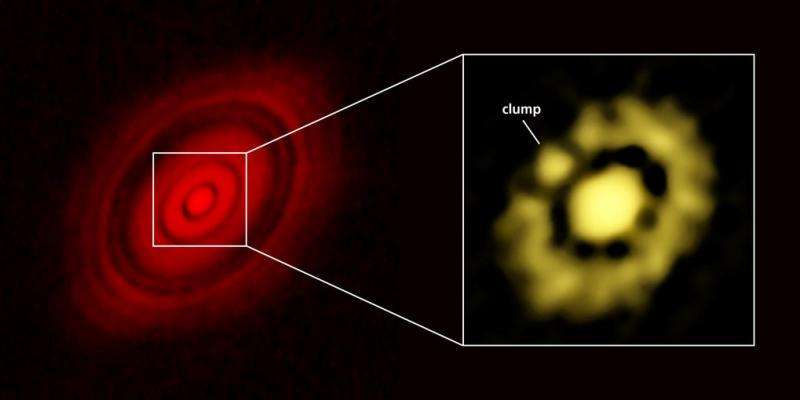Speedy planet birth: Astronomers observe a clump of dust in the disk around star HL Tauri

Observations using the VLA radio telescope array in New Mexico show the innermost portion of a planetary birthplace around the young star HL Tauri in unprecedented detail. Clearly visible is a lump of dust with 3 to 8 times the mass of the Earth, which represents the ideal conditions for the formation of a planet: a planetary nursery with sufficient building material for a planet somewhere between the mass of our own Earth and that of Neptune. The presence of a lump points towards a solution for a fundamental problem of planet formation: how planets can form on the limited time scale available for such processes.
New observations using the Karl G. Jansky Very Large Array (VLA) in New Mexico have produced some of the sharpest radio images yet of the disk around the young star HL Tauri. Earlier images taken with the ALMA observatory had already shown a characteristic pattern of dust rings and gaps in the disk. The new image shows a massive lump of dust in the innermost bright ring, a dust concentration with a mass between 3 and 8 times that of the Earth. MPIA director and co-leader of the discover team Thomas Henning says: "This lump looks like a 'planetary embryo', which is likely to develop into a fully grown planet over the next millions of years."
The new discovery has wider implications: It has long been known that the simplest models of planet formation have a problem with time scales. In these models, the protoplanetary disks made of gas and dust, which a newly born star, are smooth and homogeneous. All the action happens on small scales, with dust grains sticking to each other and forming ever larger objects, until at long last planets are formed.
But this is a rather slow process - too slow, since time is limited: Over the course of ten million years or so, gas and dust in the disk are driven away by the young star's intense radiation. Without gas and dust as raw material, planet formation will stop altogether. If the star has not managed to form large planets by then, it never will.
The new images appear to show a sped-up, ultra-fast mode of planet formation: Gas flow within the disk produces local concentrations of dust, and planet formation processes in these high-dust regions can proceed much more quickly than usual. Hubert Klahr, leader of the MPIA Planet and Star Formation Theory Group, explains: "Ten years ago, we found first indications of such ultra-fast planet formation processes in our simulations. This is the first time that observations have shown us the details: High density dust rings that appear to form lumpy fragments."
Further studies and analyses are underway to model the HL Tauri disk in detail, and to show that the giant lump is indeed attracting nearby matter to grow ever larger. Thomas Henning concludes: "Highly detailed images such as this are raising planet formation research to a new level. Apparently, disk structures such as the lump that we discovered are necessary if we want to explain the formation of systems like our own Solar System."
More information: The VLA view of the HL Tau Disk - Disk Mass, Grain Evolution, and Early Planet Formation. arxiv.org/abs/1603.03731
Provided by Max Planck Society



















